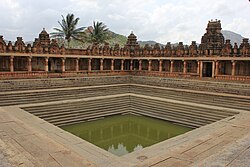

Temple tanks are wells or reservoirs built as part of the temple complex near Indian temples. They are called pushkarini, kalyani, kunda, sarovara, tirtha, talab, pukhuri, ambalakkuḷam, etc. in different languages and regions of India. Some tanks are said to cure various diseases and maladies when bathed in. It is possible that these are cultural remnants of structures such as the Great Bath of Mohenjo-daro or Dholavira, which was part of the Indus Valley civilization. Some are stepwells with many steps at the sides.
Tank design
Since ancient times, the design of water storage has been important in India's temple architecture, especially in western India where dry and monsoon seasons alternate. Temple tank design became an art form in itself. An example of the art of tank design is the large, geometrically spectacular Stepped Tank at the Royal Center at the ruins of Vijayanagara, the capital of the Vijayanagara Empire, surrounding the modern town of Hampi. It is lined with green diorite and has no drain. It was filled by aqueduct.
The tanks are used for ritual cleansing and during rites of consecration. The water in the tank is deemed to be sacred water from the Ganges River.
Stepwell
In India, a stepwell is a deep masonry well with steps going down to the water level in the well. It is called a vav in west India and a baoli in north India. Some were built by kings and were richly ornamented. They often were built by nobility, some being for secular use from which anyone could obtain water.
Haridra Nadhi
| Haridra Nadhi |
|---|
|
Haridra Nadhi, tank of the Rajagopalaswamy Temple, Mannargudi, is one of the largest temple tanks in India. It is located in Mannargudi, Thiruvarur District of Tamil Nadu.
The area of the temple tank is 23 acres (93,000 m). It is also called Daughter of Kaveri river.
Kalyani
Kalyani, also called pushkarani, are ancient Hindu stepped bathing wells.
These wells were typically built near Hindu temples to accommodate bathing and cleansing activities before prayer. They are also used for immersion of Ganesha idols during Ganesha Chaturthi.
Sarovar
In Sikhism, temple tanks are called sarovar (Punjabi: ਸਰੋਵਰ sarōvara).
Gallery
-
 Sarovar at the Sikh Harmandir Sahib, the "Golden Temple" at Amritsar, Punjab
Sarovar at the Sikh Harmandir Sahib, the "Golden Temple" at Amritsar, Punjab
-
 A temple tank at Chennakesava Temple in Belur, Karnataka.
A temple tank at Chennakesava Temple in Belur, Karnataka.
-
 Kusuma Sarovar Ghat in Mathura district, Uttar Pradesh
Kusuma Sarovar Ghat in Mathura district, Uttar Pradesh
-
 Hoysala stepped temple tank at Hulikere, Karnataka
Hoysala stepped temple tank at Hulikere, Karnataka
-
 Tank at Shravanabelagola, Karnataka
Tank at Shravanabelagola, Karnataka
-
Large kalyani at Mahanandi, Andhra Pradesh
-
Well at Trikuteshwara temple, Gadag, Karnataka
-
 Pond at Shiva temple near Kottakkal, Kerala
Pond at Shiva temple near Kottakkal, Kerala
-
 Temple pond on way to Thiruvalllur, Tamil Nadu
Temple pond on way to Thiruvalllur, Tamil Nadu
-
Tank at Thillai Nataraja Temple, Chidambaram, Tamil Nadu
-
 Pushkarini at Simhachalam
Pushkarini at Simhachalam
-
 Yaganti Tank in Andhra Pradesh
Yaganti Tank in Andhra Pradesh
-
 Temple tank, Andhra Pradesh
Temple tank, Andhra Pradesh
-
 Example of a Shiva temple in a tank (Baroli Temples)
Example of a Shiva temple in a tank (Baroli Temples)
-
 Garuda Kunda in Bhaktapur, Nepal
Garuda Kunda in Bhaktapur, Nepal
-
 Godawari Kunda, Godawari, Nepal
Godawari Kunda, Godawari, Nepal
See also
Notes
- "Sun Temples in India". Retrieved 2007-02-24.
- Shuichi Takezawa (August 2002). "Stepwells – Cosmology of Subterranean Architecture as seen in Adalaj" (PDF). Journal of Architecture and Building Science. 117 (1492): 24. Retrieved 2009-11-18.
- "Architecture - Stepwells". Archived from the original on October 6, 1999. Retrieved 2007-01-09.
- "Great Tank". art-and-archaeology. Retrieved 2007-01-13.
- Thapar, Binda (2004). Introduction to Indian Architecture. Singapore: Periplus Editions. p. 43. ISBN 0-7946-0011-5.
- "Architecture of the Indian Subcontinent - glossary". Retrieved 2006-12-18.
- "Vav / vavdi / Baoli / Bavadi - Traditional stepwells". Retrieved 2006-12-19.
- Harban Singh (1998). Encyclopedia of Sikhism. Punjabi University. p. 71. ISBN 978-81-7380-530-1.
Further reading
- C.P.R. Environmental Education Centre (2002). Sacred tanks of South India. pp. 328.
External links
- ENVIS Centre for Conservation of Ecological Heritage and Sacred Sites of India: Sacred Waterbodies of India Archived 2016-08-06 at the Wayback Machine
| Worship in Hinduism | |||||||
|---|---|---|---|---|---|---|---|
| Main topics | |||||||
| Rituals |
| ||||||
| Mantras | |||||||
| Objects | |||||||
| Materials | |||||||
| Instruments | |||||||
| Iconography | |||||||
| Places | |||||||
| Roles | |||||||
| Sacred animals | |||||||
| Sacred plants |
| ||||||
| See also | |||||||
